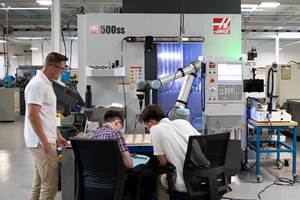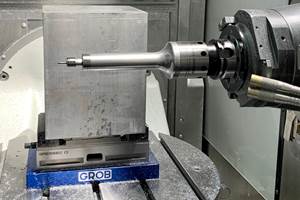Direct Part Marking Enhances Product Traceability
The ability to mark workpieces is an important service that many job shops and product manufacturers must offer their customers. Marking allows parts to be identified and traced to their origin.
Share





The ability to mark workpieces is an important service that many job shops and product manufacturers must offer their customers. Marking allows parts to be identified and traced to their origin. Laser marking systems have been especially popular because the computer controlled laser is extremely fast and accurate. However, laser marking has been of limited value to users interested in marking metal parts with machine readable bar codes. A system for laser marking that offers significant advantages for marking metal products directly on the surface of the metal is the VectorMark laser marking system developed by Trumpf (Farmington, Connecticut). This laser marking system overcomes the drawbacks with traditional bar code systems for laser marking metal parts. This new system uses diode pumped laser technology for the data matrix format of encoded markings.
A laser is a light amplifier. It has a relatively low power initial light source, a resonator where energy is converted from radio frequency energy to light energy, and a relatively high power output. Laser marking systems that use traditional thermal flash lamp technology are impractical for making bar codes that can be read by machine. These laser systems could not produce the high contrast required for bar code scanners to read markings made directly on aluminum or steel surfaces. Although laser markers could hold very tight specifications on bar width, height, spacing and so on, for traditional bar codes, the lack of contrast on metal products often prevented the old type of bar code scanners from reading the codes reliably. These scanners reflected a bright light off the substrate to detect the markings.
According to its developers, a diode pumped laser marking system has 20 to 40 times the life of thermal flash technology systems. It is also said to have 2.5 times better mark resolution, lower energy consumption, and lower initial capital cost. The data matrix format for product codes solves the lack-of-contrast problem for laser marking of metal surfaces. Data matrix marking reduces the required contrast (typically from 70 to 20 percent) so that these codes can be read with exceptionally high reliability by a device similar to a digital camera, even when the marks are made on steel or aluminum surfaces.
The data matrix format also allows for more information to be put on a part. Officials from Trumpf say that their diode pumped laser marking system can encode the equivalent of 2,800 characters per square inch on a workpiece surface.
Direct laser marking has proven to be a significant part of growing operations for job shops such as Begneaud Manufacturing of Lafayette, Louisiana. Founded as a welding shop servicing the Gulf Coast oil patch industry, the shop grew into a full-service metal fabricator with customers in a wide variety of industries. Founder Don Begneaud attributes the growth of his shop's laser marking operations to three factors: the diode pumped laser technology, the advent of data matrix coding systems, and growing interest in direct part marking.
According to Mr. Begneaud, interest in direct marking for aerospace parts is being led by initiatives from Pratt & Whitney, Boeing and Airbus among others. "We see the acceptance of laser marking and data matrix more and more each day," he says. Mr. Begneaud also cites a shift to direct marking throughout the automotive industry, especially with suppliers to GM Powertain and Ford Powertrain divisions. Major players in both the medical industry and tooling industry are also moving to direct part marking, he says.
Related Content
The Future of High Feed Milling in Modern Manufacturing
Achieve higher metal removal rates and enhanced predictability with ISCAR’s advanced high-feed milling tools — optimized for today’s competitive global market.
Read MoreCNC Machine Shop Honored for Automation, Machine Monitoring
From cobots to machine monitoring, this Top Shop honoree shows that machining technology is about more than the machine tool.
Read MoreHow to Determine the Currently Active Work Offset Number
Determining the currently active work offset number is practical when the program zero point is changing between workpieces in a production run.
Read MoreHigh RPM Spindles: 5 Advantages for 5-axis CNC Machines
Explore five crucial ways equipping 5-axis CNC machines with Air Turbine Spindles® can achieve the speeds necessary to overcome manufacturing challenges.
Read MoreRead Next
Machine Shop MBA
Making Chips and 91ÊÓƵÍøÕ¾ÎÛ are teaming up for a new podcast series called Machine Shop MBA—designed to help manufacturers measure their success against the industry’s best. Through the lens of the Top Shops benchmarking program, the series explores the KPIs that set high-performing shops apart, from machine utilization and first-pass yield to employee engagement and revenue per employee.
Read MoreAMRs Are Moving Into Manufacturing: 4 Considerations for Implementation
AMRs can provide a flexible, easy-to-use automation platform so long as manufacturers choose a suitable task and prepare their facilities.
Read MoreLast Chance! 2025 Top Shops Benchmarking Survey Still Open Through April 30
Don’t miss out! 91ÊÓƵÍøÕ¾ÎÛ's Top Shops Benchmarking Survey is still open — but not for long. This is your last chance to a receive free, customized benchmarking report that includes actionable feedback across several shopfloor and business metrics.
Read More





















